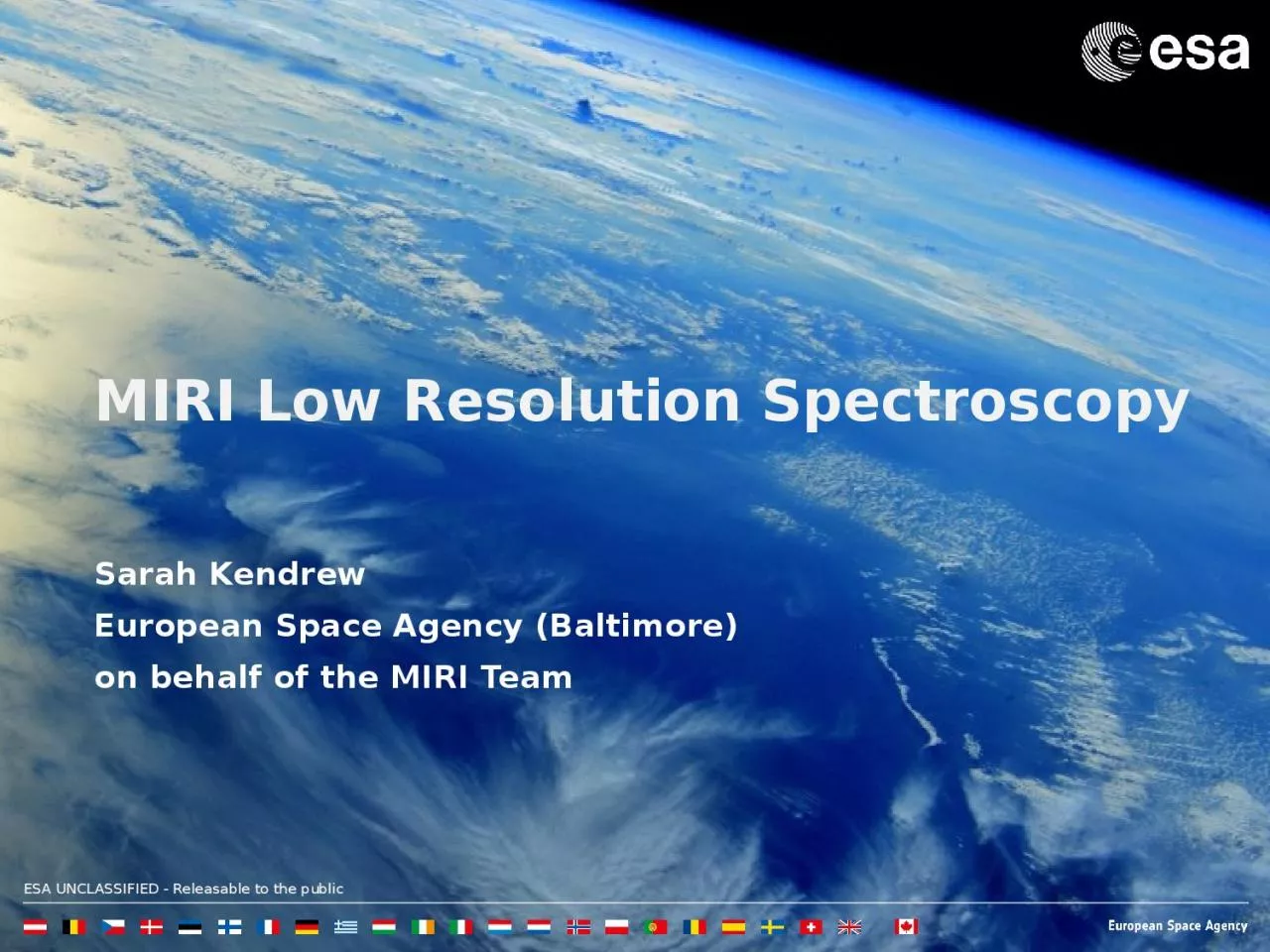

on behalf of the MIRI Team MIRI Low Resolution Spectroscopy Lowresolution Spectroscopy Overview Design and operating principles Focal plane locations LRS testing amp data Preparing an LRS observation slit vs slitless ID: 1006743
Download Presentation The PPT/PDF document "Sarah Kendrew European Space Agency (Bal..." is the property of its rightful owner. Permission is granted to download and print the materials on this web site for personal, non-commercial use only, and to display it on your personal computer provided you do not modify the materials and that you retain all copyright notices contained in the materials. By downloading content from our website, you accept the terms of this agreement.
1. Sarah KendrewEuropean Space Agency (Baltimore)on behalf of the MIRI TeamMIRI Low Resolution Spectroscopy
2. Low-resolution Spectroscopy OverviewDesign and operating principlesFocal plane locationsLRS testing & dataPreparing an LRS observation: slit vs. slitlessPerformanceStrengths & weaknessesFurther reading: Kendrew et al, PASP 2015 and SPIE 2016: MIRI LRSBouchet at al, PASP 2015: MIRI ImagerGlasse et al, PASP 2015: MIRI SensitivityGordon et al, PASP 2015: MIRI Operations
3. LRS Basics & DesignR ~ 100 spectroscopy of compact sources from 5- (10) 12 µm (~40 to 160 over the 5-10 µm range)Can be operated in slitted (4.7 x 0.52”) or slitless modeShares focal plane with the imager & coronagraph modesDispersion via double prism in filter wheelImager focal planeµmpx
4. Focal plane layoutSlitless spectroscopy:Fixed pointing positionSubarray readoutMin. frame time 0.16s Slitted spectroscopy:Fixed slit locationFull array readoutImager field not blocked5-12 µm spectrum dispersed over ~370 pxDedicated target acquisition region
5. An LRS Spectrum
6. LRS TestingNumerous test campaignsMIRI Imager testing @ CEA Saclay, 2009-2010MIRI flight test campaign @ RAL, 2011CV campaigns @ Goddard, 2013-2016JPL detector testing (persistence, subarrays etcFurther analysis & modelingSensitivity, PCE, detector yield (see Glasse, Dicken)PSF modeling(artefact)
7. Preparing an LRS observation: SLITSource: point or extendedTarget acquisition:Choice of 4 filtersDedicated TA regionNot compulsoryDithering2 along-slit nodsOff-slit backgroundRead mode FAST/SLOWImager focal plane
8. Preparing an LRS observation: SLITLESSChoice of slitless mode triggers Time Series Observation operational modeDedicated subarray & pipeline branch Target acquisition (TBD):Choice of 4 filters (NDF likely)Centroiding in slitless subarrayNO DitheringMax exposure time of 3 hours WAIVEDMin. frame time in FAST: 0.17s
9. Astronomers Proposal Tool: LRS templateFULLSLITLESS (SUBPRISM)Point sourceExtended targetSLOWFASTNGROUPS currently ≥ 4 (TBD)
10. Performance: Line sensitivity (SLIT)Glasse et al, PASP 2015 (erratum)SLITLESS sensitivity: Factor ~10 worseNB: does not yet include revised detector quantum yield
11. Performance: Continuum sensitivity (SLIT)Glasse et al, PASP 2015 (erratum)SLITLESS sensitivity: Factor ~10 worseNB: does not yet include revised detector quantum yield
12. Bright limits (SLIT)Assumes 2-frame reads, < 60% full wellFull array FAST mode (frame time ~3s)Min value: 63 mJy @ 5.5 µm (K~8)SLITLESS MODE: Factor 17 higherGlasse et al, PASP 2015NB: does not yet include revised detector quantum yield
13. Limitations/Open QuestionsSlitless/Time Series Observations: Effect of the turnover in dispersion?Bright limitsAchievable stability & precision for very short rampsCalibration data products based on ground test dataFocused on nominal range of 5-10 µmPSF model not yet optimalWavelength calibration for λ < 5 µm and λ > 10 µm has larger uncertaintiesµmpx
14. LRS strengths & weaknessesSTRENGTHSBuilt by the same heroes as the MIRI ImagerMeets & exceeds requirements e.g. wavelength coverageExcellent complement to MRS and NIR spectroscopic modes:low-resolution, instantaneous broad wavelength coverageSlitless mode offers the ability to perform high-quality time series observations, e.g. suitable for MANY exoplanet host starsWEAKNESSES (/CAVEATS)Spectral foldover below 4.5 µm unmitigated for slitless modeCalibration not yet optimal, especially outside the nominal range